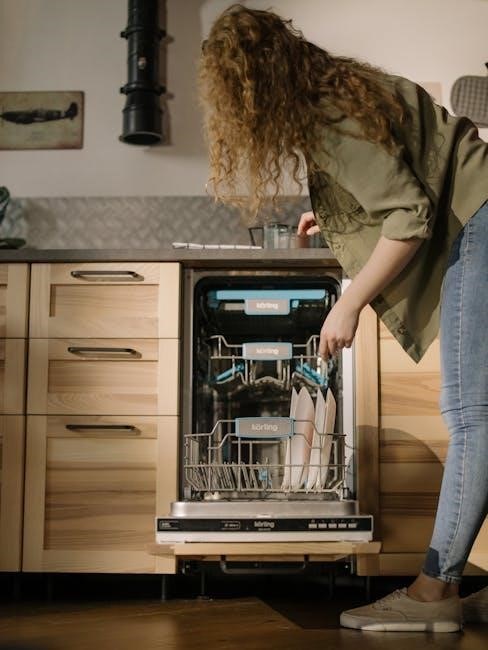
ge front load washer user manual
Welcome to the GE Front Load Washer User Manual! This guide provides essential information for safe installation‚ operation‚ and maintenance of your appliance․ It covers key features‚ troubleshooting‚ and best practices to ensure optimal performance and longevity of your washer․
1․1 Overview of the GE Front Load Washer
The GE Front Load Washer is designed for efficient and reliable laundry care․ Available in various capacities‚ including 2․4 cu․ ft․ to 4․8 cu․ ft․‚ it offers advanced features like smart connectivity‚ energy efficiency‚ and multiple wash cycles․ Models such as the GFW148SSMWW and GFW550SSNWW include steam technology and the UltraFresh Vent System for odor prevention․ This washer supports WiFi connectivity and custom settings‚ ensuring tailored cleaning for every load․
1․2 Importance of Reading the User Manual
Reading the GE Front Load Washer User Manual is crucial for safe and effective operation․ It provides essential safety guidelines‚ installation instructions‚ and maintenance tips to ensure optimal performance․ The manual helps users understand energy-efficient settings‚ troubleshoot common issues‚ and utilize advanced features like smart connectivity and steam technology․ By following the manual‚ you can avoid potential hazards‚ extend the appliance’s lifespan‚ and achieve the best laundry results․

Key Features of the GE Front Load Washer
The GE Front Load Washer offers advanced features such as large capacity options‚ smart connectivity for remote control‚ energy-efficient cycles certified by ENERGY STAR‚ and specialized washing cycles like steam technology․ Additional features include the UltraFresh vent system to prevent odors and mold‚ multiple wash speeds‚ and compatibility with smart home systems․ These features enhance convenience‚ efficiency‚ and performance‚ making it a versatile and modern laundry solution․
2․1 Capacity and Size Options
GE Front Load Washers are available in various capacities‚ including 4․5 cu․ ft․‚ 4․8 cu․ ft․‚ and 5․0 cu․ ft․‚ catering to different household needs․ Compact models like the 24-inch wide 2․4 cu․ ft․ washer are ideal for small spaces‚ while larger models accommodate bulkier loads․ The washers feature flexible sizing options to fit diverse laundry demands‚ ensuring efficient cleaning for any family size or laundry requirement․
2․2 Smart Connectivity and Energy Efficiency
GE Front Load Washers feature smart connectivity‚ enabling remote monitoring and control via smartphone apps․ Many models are ENERGY STAR certified‚ ensuring energy and water efficiency․ Advanced sensors optimize wash cycles‚ reducing energy consumption․ Smart features like customizable settings and real-time notifications enhance user convenience‚ while eco-friendly modes minimize environmental impact‚ making these washers both innovative and environmentally responsible․
2․3 Special Washing Cycles and Options
GE Front Load Washers offer diverse specialized cycles like Steam Clean‚ Sanitize‚ and UltraFresh Vent for odor control․ Additional options include custom soil levels‚ temperature settings‚ and silent operation modes․ The UltraFresh Vent system prevents mold growth‚ while advanced sensors detect fabric types to tailor wash cycles‚ ensuring gentle care for delicates and deep cleaning for heavily soiled items‚ providing versatility for all laundry needs․
Installation and Setup
Proper installation ensures optimal performance․ Prepare the site‚ level the washer‚ connect water and power‚ and check hoses for damage to ensure safe operation․
3․1 Preparing the Installation Site
Ensure the installation site is level‚ stable‚ and near a water supply․ Clear the area of obstructions and check floor strength to support the washer’s weight․ Verify proper drainage and proximity to power outlets․ Inspect the floor for levelness and make adjustments if necessary to prevent vibration during operation․ Ensure the site is well-ventilated and protected from extreme temperatures for optimal performance and longevity of the appliance․
3․2 Leveling and Balancing the Washer
Proper leveling and balancing are crucial for smooth operation․ Place the washer on a firm‚ level surface and adjust the legs to ensure stability․ Use a level tool to check alignment and prevent wobbling․ Tighten the legs securely after adjustments․ Ensure the washer is balanced to avoid vibration during cycles․ Improper leveling can lead to noise‚ poor performance‚ or damage‚ so double-check the balance before first use․
3․3 Connecting Water and Power Supplies
Connect the washer to a cold and hot water supply using the provided hoses․ Ensure all connections are secure and leak-free․ Plug the washer into a 120V grounded outlet‚ preferably on a dedicated circuit․ Avoid using extension cords․ Verify water pressure meets manufacturer specifications and power supply aligns with the washer’s requirements․ Follow safety guidelines to prevent electrical or water-related hazards during installation and operation․
Loading and Detergent Usage
Load clothes loosely‚ no higher than the top row of holes in the tub․ Use detergent amounts suitable for load size and soil level․ Avoid overloading․
4․1 Proper Loading Techniques
Load clothes loosely‚ ensuring they do not exceed the top row of holes in the washer tub․ Avoid overloading‚ as this can reduce cleaning efficiency and cause imbalance․ Distribute heavier items evenly and mix large and small garments for optimal washing performance․ Leave enough space for clothes to move freely during cycles․ Proper loading ensures better cleaning‚ prevents damage‚ and maintains washer stability․
4․2 Recommended Detergent Types and Amounts
Use high-efficiency (HE) detergent designed for front-load washers to minimize suds and prevent residue buildup․ Measure detergent according to the manufacturer’s instructions and the washer’s guidelines․ Place detergent in the dispenser or manually add it before starting the cycle․ Adjust amounts based on load size and soil level․ Avoid over-dosing‚ as it can leave residue․ For heavily soiled loads‚ follow specific guidelines for adding Oxi or booster products․

Operating the Washer
Select the desired wash cycle and options using the control panel․ Press Start to begin the cycle․ Monitor progress via the display and adjust settings if needed․
5․1 Selecting Wash Cycles and Options
To select the appropriate wash cycle‚ choose from options like Normal‚ Heavy Duty‚ or Delicates based on load type․ Adjust settings such as Spin Speed‚ Soil Level‚ and Steam to customize the cycle․ Use the control panel to navigate and confirm selections․ Ensure the cycle matches fabric types and soil levels for optimal cleaning․ Refer to the manual for detailed descriptions of each cycle and option to ensure the best results for your laundry․
5․2 Using the Control Panel and Smart Features
Your GE Front Load Washer features an intuitive control panel with a touchscreen interface․ Use it to select cycles‚ adjust settings‚ and monitor progress․ Smart features like WiFi connectivity allow you to control the washer via a mobile app․ Enable remote start‚ receive cycle completion notifications‚ and monitor maintenance needs․ Some models also support voice commands through smart speakers․ Refer to the manual for pairing instructions and explore advanced settings for customized laundry care․
5․3 Starting and Monitoring Wash Cycles
To start a wash cycle‚ press the Start button after selecting your desired settings․ The washer door will lock‚ and the cycle will begin․ Monitor progress using the digital display or through the GE SmartHQ app․ The app provides real-time updates‚ cycle status‚ and notifications when the wash is complete․ For models with advanced features‚ you can pause or cancel cycles mid-progress․ Always ensure the door is closed securely before starting to avoid interruptions․
Maintenance and Cleaning
Regular maintenance ensures optimal performance․ Clean the gasket‚ drain pump‚ and interior․ Run cleaning cycles to remove residue and prevent odors․ Check and replace worn hoses periodically․
6․1 Cleaning the Gasket and Drain Pump
Regularly clean the gasket and drain pump to prevent mold and odors․ Leave the washer door open after use to dry the interior․ Remove and rinse the drain pump filter monthly․ Wipe the gasket with a mild detergent solution․ Ensure all parts are dry to avoid moisture buildup․ Refer to your manual for specific cleaning instructions to maintain your washer’s hygiene and performance․
6․2 Running a Cleaning Cycle
Regularly run a cleaning cycle to maintain your GE front load washer’s hygiene․ Select the “Clean” or “Clean Washer” cycle‚ typically using hot water․ Add a washer cleaner or 1 cup of white vinegar if recommended․ Leave the door open after the cycle to dry the interior․ This helps eliminate odors and prevents mold buildup․ Follow the manual’s specific instructions for your model to ensure optimal cleaning and freshness․
6․3 Checking and Replacing Hoses
Inspect the water supply hoses regularly for cracks‚ bulges‚ or wear․ Replace them every 5 years or as recommended in your GE washer’s manual․ Ensure hoses are securely connected to both the washer and water supply lines to prevent leaks․ If damage is found‚ turn off the water supply before replacing the hoses․ This maintenance helps prevent water damage and ensures reliable performance․ Always follow the manufacturer’s guidelines for replacement․

Troubleshooting Common Issues
Identify symptoms‚ check error codes‚ and refer to the troubleshooting guide in your manual․ Address issues like odor‚ noise‚ or vibration by following recommended solutions or contacting support․
7․1 Identifying and Resolving Error Codes
Refer to your GE Front Load Washer manual for specific error codes․ Common codes like PF‚ E1‚ or E2 indicate issues like power failures or sensor malfunctions․ Reset the washer by pressing and holding the Start/Pause button for 3 seconds․ If issues persist‚ check water supply‚ drain hoses‚ or balance․ For unclear codes‚ consult the troubleshooting section or contact GE support for assistance․ Always follow safety guidelines when resolving errors․
7․2 Addressing Odor and Mold Issues
Front-load washers can sometimes develop odors or mold due to moisture buildup․ Regularly clean the gasket and drain pump filter․ Run a cleaning cycle with an approved cleaner or vinegar․ Leave the door open after use to dry the interior․ Check for blockages in the drain hose and ensure proper ventilation․ If odors persist‚ refer to the troubleshooting guide or contact GE support for further assistance․
7․3 Solving Noise or Vibration Problems
Noise or vibration issues in your GE front-load washer can often be resolved by ensuring proper installation and balancing․ Check that the washer is leveled correctly and adjust the legs if necessary․ Loose parts or an uneven load can also cause vibration․ Verify that the drain pump filter is clear of debris․ If noise persists‚ consult the troubleshooting section in your manual or contact GE customer support for assistance․

Safety Information
Always follow safety guidelines to ensure safe operation of your GE front-load washer․ Read the manual thoroughly and avoid hot surfaces․ Keep children away from the washer during operation․
Ensure proper installation and use only recommended parts․ Never overload the washer‚ as this can cause imbalance and potential hazards․ Regularly inspect hoses and connections for wear․
8․1 General Safety Precautions
Always read and follow the safety guidelines in this manual to ensure safe operation of your GE front-load washer․ Keep children away from the washer during operation and supervision when they are nearby․ Avoid touching hot surfaces‚ such as the washer drum‚ after a cycle․ Never overload the washer‚ as this can cause imbalance and potential hazards․ Ensure the washer is properly installed and levelled to prevent vibration or tipping․
Regularly inspect hoses and connections for signs of wear or damage․ Replace worn-out parts immediately to avoid leaks or other safety issues․ Do not use harsh chemicals or abrasive cleaners‚ as they may damage the washer or pose a risk to users․ Follow all electrical safety guidelines to prevent shocks or fires․ By adhering to these precautions‚ you can enjoy safe and efficient use of your GE front-load washer․
8;2 Electrical and Water Safety Guidelines
Ensure your GE front-load washer is installed by a qualified technician to meet electrical and plumbing standards․ Use a grounded‚ 120V electrical outlet and avoid overloading circuits․ Keep the washer on a level surface to prevent water leakage or electrical hazards․ Regularly inspect water hoses for signs of wear and replace them every 5 years․ Never submerge the washer in water‚ and avoid using it near swimming pools or wet environments․ Always turn off water and power supplies during maintenance to prevent accidents․

Warranty and Support
Your GE front-load washer is backed by a limited warranty covering parts and labor․ Visit the GE Appliances website for detailed warranty terms and support options․ Register your product for enhanced assistance and access to exclusive resources․ For inquiries‚ contact GE Customer Support at 1-800-626-2005 or refer to your user manual for additional information․
9․1 Understanding the Limited Warranty
The limited warranty for your GE front-load washer covers parts and labor for a specified period․ It applies to the original purchaser and requires product registration for validation․ The warranty excludes normal wear‚ misuse‚ or unauthorized repairs․ Review the warranty terms in your user manual or on the GE Appliances website for detailed coverage and exclusions․ Contact GE Customer Support at 1-800-626-2005 for assistance with warranty-related inquiries or claims․
9․2 Contacting GE Customer Support
For assistance with your GE front-load washer‚ contact GE Customer Support at 1-800-626-2005․ Support is available Monday through Friday‚ 8 AM to 8 PM ET‚ and Saturday‚ 8:30 AM to 5 PM ET․ Visit geappliances․com for live chat‚ email support‚ or to find answers to common questions․ Ensure you have your model number and serial number ready for faster service․
10․1 Maximizing the Lifespan of Your Washer
Regular maintenance and proper usage are key to extending the life of your GE Front Load Washer․ Ensure the washer is leveled and installed correctly to prevent vibration and imbalance․ Use the recommended detergent amounts and avoid overloading․ Clean the gasket and drain pump regularly to prevent mold buildup․ Check and replace hoses every 5 years‚ and run cleaning cycles periodically․ Proper care ensures efficient performance and longevity․
10․2 Final Tips for Optimal Performance
To ensure your GE Front Load Washer performs optimally‚ always leave the door open after cycles to dry the interior․ Check detergent usage guidelines to avoid overloading‚ and ensure proper load sizes․ Regularly clean the gasket and run cleaning cycles to maintain freshness․ Inspect hoses every 5 years and replace as needed․ Utilize smart features for energy efficiency and monitor wash cycles to prevent overloading․ Proper care enhances performance and keeps your washer in peak condition․